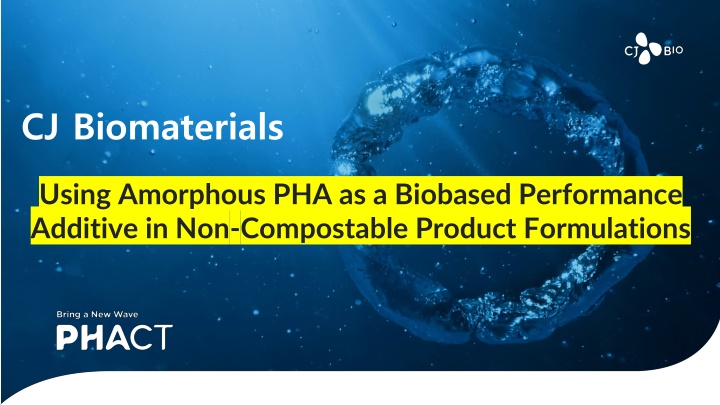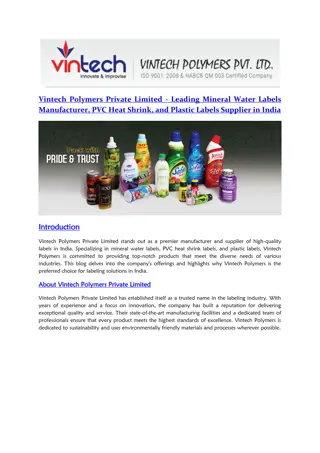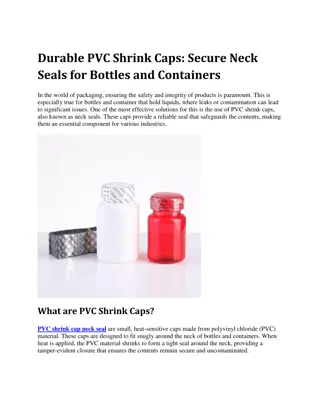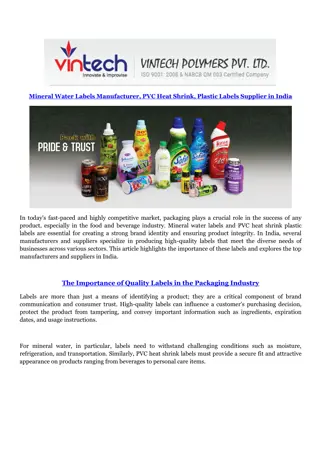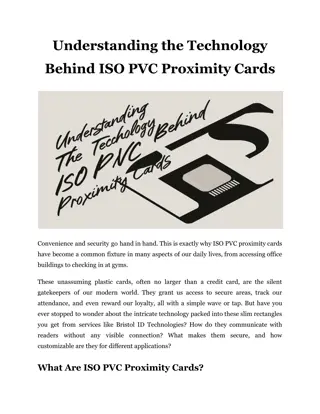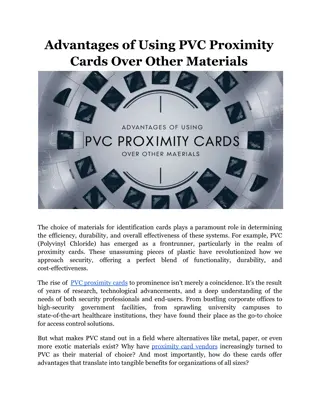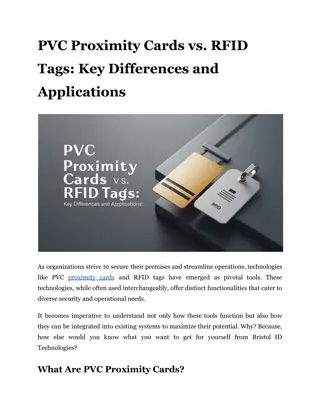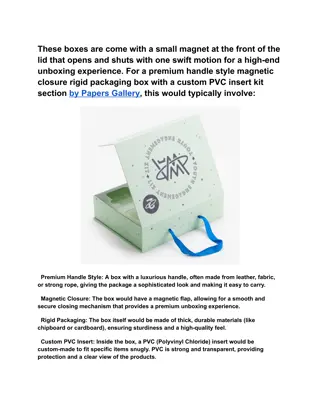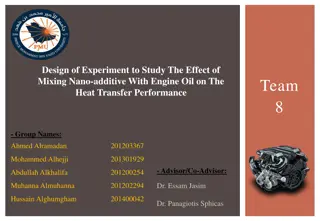Enhancing PVC Performance with Bio-Based Additive
Incorporating amorphous PHA in non-compostable PVC formulations offers bio-based carbon content and enhances toughness, flexibility, tear resistance, and surface finish. This innovative approach enables higher mineral loading for recycled PVC, increases filler loading levels, and aids faster fusion while maintaining UV stability. Evaluating aPHA incorporation in PVC by Bioplastic Solutions in Minneapolis showcases the potential for sustainable advancements in polymer applications.
Download Presentation

Please find below an Image/Link to download the presentation.
The content on the website is provided AS IS for your information and personal use only. It may not be sold, licensed, or shared on other websites without obtaining consent from the author.If you encounter any issues during the download, it is possible that the publisher has removed the file from their server.
You are allowed to download the files provided on this website for personal or commercial use, subject to the condition that they are used lawfully. All files are the property of their respective owners.
The content on the website is provided AS IS for your information and personal use only. It may not be sold, licensed, or shared on other websites without obtaining consent from the author.
E N D
Presentation Transcript
CJ Biomaterials Using Amorphous PHA as a Biobased Performance Additive in Non-Compostable Product Formulations
Non-Compostable Opportunities Value Proposition: Add bio-based carbon content while simultaneously enhancing toughness and flexibility Our initial market & application focus has been on performance enhancement of compostable polymers such as PLA, PBS and PBAT. We are now exploring the value proposition of incorporating amorphous PHA rubber into non-compostable product formulations. 2
Non-Compostable Opportunities Specific Opportunities PVC Acetals Nylon-11 & Nylon-12 EVA TPU PVOH 3
Non-Compostable Opportunities - PVC Add bio-based carbon content while simultaneously enhancing toughness and flexibility Why aPHA in PVC Formulations? 100% bio-based, non-phthalate, miscible polymeric plasticizer Also, PHA does not migrate from PVC even at high loadings Applicable to flexible and semi-rigid applications Improves toughness, flexibility, tear resistance and surface finish Enables higher mineral loading for recycled PVC Incorporating 2.5% aPHA enables maximum filler loading levels to increase from 20 wt% to 45 wt% Promotes shear melting of PVC and aids faster fusion Considerably better than CPE and other core-shell impact modifiers Maintains the UV stability of PVC 4
Non-Compostable Opportunities - PVC Add bio-based carbon content while simultaneously enhancing toughness and flexibility 140 450 400 120 Elongation @ Break (%) Tensile Modulus (MPa) 350 100 300 80 250 60 200 150 40 100 20 5% PHACT 5% PHACT PVC Control PVC Control Lower modulus (higher flexibility) and higher tensile elongation with only 5% PHACT in PVC 5
Non-Compostable Opportunities - PVC Add bio-based carbon content while simultaneously enhancing toughness and flexibility 28 8 26 Tensile Strength (MPa) 24 Energy @ Break (J) 6 22 20 4 18 16 2 14 12 0 10 5% PHACT 5% PHACT PVC Control PVC Control Higher toughness and higher tensile strength with only 5% PHACT in PVC
ACTIONS FOR PVC Bioplastic Solutions in Minneapolis is evaluating aPHA incorporation into their profile extrusion applications. Had one discussion with Westlake to incorporate aPHA into their new planned partially-biobased PVC products [from bio-based ethylene]. Need to follow-up. Will present at SPE ANTEC conference to evaluate further interest in the PVC space. 7
Non-Compostable Opportunities PA11 Add bio-based carbon content while simultaneously enhancing toughness and flexibility Why use a PHA in Nylon-11 and Nylon-12 product formulations? Increase flexibility and toughness (up to -20 C) of low-melting polyamides Replace fossil-based plasticizer that is limited in low-temperature performance Replace N-butyl benzenesulfonamide (BBSA), a commonly used plasticizer Does not compromise the bio-based carbon content of Nylon-11 No change in the crystallization kinetics and melting temperature of Nylon-11 even up 40% aPHA Overcome drawbacks with the use of BBSA in PA-11 & PA-12 applications. (i) volatility and sweating from Nylon 11 at high end-use temperatures (ii) extraction of the BBSA by certain fluids at higher temperatures (iii) lowering of the bio-based carbon content of the Nylon 11 (iv) inadequate impact modification at temperatures close to and below -20 C due to the freezing of BBSA 8
Non-Compostable Opportunities PA11 Add bio-based carbon content while simultaneously enhancing toughness and flexibility 1300 110 1200 Tensile Modulus (MPa) Izod Impact (J/m) 100 1100 90 1000 900 80 800 Impact testing at room temperature and -20 C Blends with 20% A1000P showed "complete" breaks Blends with 30 & 40% A1000P showed "hinge" and "non" breaks 70 700 60 600 0 5 10 15 20 25 0 10 20 30 40 Wt% PHACT A1000P Wt% PHACT A1000P Lower modulus (& higher flexibility) and higher toughness with aPHA in PA-11
Non-Compostable Opportunities PA11 Add bio-based carbon content while simultaneously enhancing toughness and flexibility 75 36 Tensile Stress @ Break (MPa) 34 70 32 Shore D Hardness 30 65 28 60 26 24 55 22 20 50 18 45 16 0 10 20 30 40 0 10 20 30 40 Wt% PHACT A1000P Wt% PHACT A1000P Softer products with aPHA in PA-11
ACTIONS FOR PA-11 & PA-12 Had one discussion with Arkema no clear expression of interest. Need to engage compounders (engineering plastics focus) and other Nylon-11 & Nylon-12 producers. Explore the relative value proposition of Nylon-11 and Nylon-12 can aPHA address the weakness of one to strengthen its competitiveness relative to the other? Will present at SPE ANTEC conference to evaluate further interest in this space. 11
Non-Compostable Opportunities - Acetal Add bio-based carbon content while simultaneously enhancing toughness and flexibility Why use a PHA in Acetal product formulations? Enable partial bio-based carbon content in poly (acetals). Improve toughness and flexibility. Augment any bio-derived carbon in certain polymer families such as Delrin. Boost the mass-balance based bio-carbon Replace fossil-based plasticizers such as BBSA. 12
Non-Compostable Opportunities - Acetal Add bio-based carbon content while simultaneously enhancing toughness and flexibility 85 80 100 Tensile Elongation (%) Izod Impact (J/m) 75 80 70 65 60 60 40 55 Impact testing at room temperature and -20 C Blends with 10 & 20% A1000P showed "complete" breaks Blends with 30 & 40% A1000P showed "hinge" breaks 50 20 45 0 5 10 15 20 25 0 10 20 30 40 Wt% PHACT A1000P Wt% PHACT A1000P Significantly higher toughness and tensile elongation with aPHA in Acetal polymers 13
Non-Compostable Opportunities - Acetal Add bio-based carbon content while simultaneously enhancing toughness and flexibility 3000 80 Tensile Stress @ Break (MPa) Tensile Modulus (MPa) 70 2500 60 2000 50 1500 40 1000 30 500 20 0 10 20 30 40 0 10 20 30 40 Wt% PHACT A1000P Wt% PHACT A1000P Lower modulus (& higher flexibility) and lower tensile strength with aPHA in Acetal polymers 14
ACTIONS FOR Acetal Polymers Had one discussion with DuPont Delrin business cold response; now that business is part of Celanese. Need to engage Celanese, compounders (engineering plastics focus) and other producers. Explore enhancing the performance Acetal copolymers to compete with Acetal homopolymers. Will present at SPE ANTEC conference to evaluate further interest in the PVC space. 15
Non-Compostable Opportunities - EVA Add bio-based carbon content while simultaneously enhancing toughness and flexibility Why use a PHA in EVA product formulations? Enable partial bio-based carbon content in EVA. Increase softness and feel (mimic higher VA content). Exploit interest from brands such as Nike. Evaluate performance advantages in adhesive applications (polarity may be a benefit). 16
Non-Compostable Opportunities - EVA Add bio-based carbon content while simultaneously enhancing toughness and flexibility 92 550 Tensile Elongation (%) 90 500 Shore A Hardness 88 450 86 400 84 82 350 80 0 10 20 30 40 0 5 10 15 20 25 30 Wt% PHACT A1000P Wt% PHACT A1000P 17
ACTIONS FOR EVA Complete and file patent application Conduct cross-linking of EVA/aPHA blends for footwear applications Work with Adherent Labs to evaluate potential in EVA-based hot-melt adhesive applications Nike has expressed interest in this concept shared aPHA with Nike for them to explore. Nike is also interested in cross-linked, pure aPHA for footwear applications (outer and mid sole). Eliminate microplastics from wear of footwear. Will present at SPE ANTEC conference to evaluate further interest in the PVC space. 18
Non-Compostable Opportunities - TPU Add bio-based carbon content while simultaneously enhancing toughness and flexibility Why use aPHA in TPU product formulations? Enable partial bio-based carbon content in TPU. Augment bio-based carbon content in partially bio-based TPU grades Performance advantages, if any, are not clear at the moment Actions We have exchanged samples with Lubrizol. Will conduct some basic evaluations. If results show promise, Lubrizol will take the lead to drive this concept in the market. 19
Non-Compostable Opportunities - PVOH Add bio-based carbon content while simultaneously enhancing toughness and flexibility Why use a PHA in PVOH product formulations? Enable partial bio-based carbon content in PVOH. Accelerate disintegration and biodegradation of PVOH in aqueous environments including municipal waterways Actions We have exchanged samples with Aquapak. Will conduct some basic evaluations. If results show promise, Aquapak will take the lead to drive this concept in the market.
SUMMARY We have now demonstrated the value proposition of incorporating aPHA into many non- compostable polymer/product formulations. However, there are many challenges. Challenges we need to tackle to succeed in these applications: Negative (or zero) carbon footprint is a critical starting point for many applications Very challenging to match butadiene, ethylene and propylene based elastomers from a performance perspective Order of magnitude performance differential Industry is very familiar with these products Bio-PE is a tough incumbent to match [price & performance] Resources [prioritization] is a massive challenge Unclear about go-to-market strategy 21
